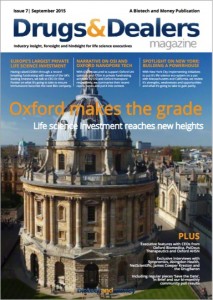Five things we learned from Rockefeller President Marc Tessier Lavigne
Biotech and Money recently caught up with Marc Tessier-Lavigne, president of the Rockefeller University, New York City. Having acted as CSO for Genentech from 2003 to 2011, Marc now finds himself in charge of what is, in his own words, “the world’s leading biomedical research university.”
What lessons has he learned from his time at these great institutions? What are his views on the future of New York’s life sciences economy? How should the city up its game? Biotech and Money brings you tips from the expert.
1. Rockefeller: Good science built on good foundations
Just what is Rockefeller’s secret to success in biological and biomedical research? According to Marc, first and foremost is attracting and supporting the best scientists in the world. At Rockefeller, one key is its administrative structure. The university has no departments, which allows scientists to get on with what they need to do with minimal distractions.
“Rockefeller’s flat structure and small size minimises bureaucracy: it’s organised to be nimble with a total commitment to supporting science and scientists.”
“Rockefeller’s flat structure and small size minimises bureaucracy: it’s organised to be nimble with a total commitment to supporting science and scientists.”
Additionally, the institution’s culture encourages scientists to pursue higher-risk/higher-reward paths with the potential to lead to transformative discoveries and novel new therapies. Rockefeller’s scientists also benefit from having access to an on-site clinical research hospital; four in 10 of the university’s scientists have at least one clinical study under way at the hospital. All these factors have contributed towards Rockefeller’s impressive Nobel Prize portfolio: more in medicine and chemistry than any other institution in the world.
2. Keeping the trajectory sky high
What exactly does a day in the life of a medical research university president look like? In Marc’s case, it means making sure Rockefeller’s infrastructure provides its scientists with everything they need to pursue their transformative research. It also means being fully engaged with a broad array of constituencies in New York City’s growing bioscience community.
“There’s a saying that great institutions never stay the same: they either get better or worse. My job as president is to help ensure that Rockefeller continues on its upward trajectory of continued superlative success.”
“There’s a saying that great institutions never stay the same: they either get better or worse. My job as president is to help ensure that Rockefeller continues on its upward trajectory of continued superlative success.”
It’s a challenging job, but with Marc’s energy, focus, and optimism, it looks like the only direction for Rockefeller is up.
3. New York City is already a fantastic biotech hub
Despite having a long way to go before reaching the same heights as Boston or San Francisco, New York still holds its own in the US biotech scene, according to Marc. In his opinion, New York is already an exciting space for life sciences, filled with academic innovation, second only to Boston in levels of NIH funding received, and number one in the US for clinical research.
Marc also lauds the city’s collaborative nature, citing New York’s Structural Biology Centre – which contains the world’s largest protein NMR facility – and the highly successful New York Genome Project as particular collaborative success stories.
“New York City, in many ways, is already is a hub on par with the top places in the country. What I discovered immediately when I came to Rockefeller was that the community within New York was extraordinarily strong and collegial.”
“New York City, in many ways, is already is a hub on par with the top places in the country. What I discovered immediately when I came to Rockefeller was that the community within New York was extraordinarily strong and collegial.”
4. On the importance of developing New York’s life sciences commercial sector
“There’s a strong belief that if you don’t have a commercial life science sector, then a lot of ideas just stay in the lab and don’t get developed. … It’s part of our university’s mission not just to make great scientific discoveries, but to see they’re applied for the benefit of humanity. A key part of that is getting therapeutics through the clinic and to the market place, where they can help patients. As a community, we don’t do enough of that in New York yet.”
“There’s a strong belief that if you don’t have a commercial life science sector, then a lot of ideas just stay in the lab and don’t get developed. … It’s part of our university’s mission not just to make great scientific discoveries, but to see they’re applied for the benefit of humanity. A key part of that is getting therapeutics through the clinic and to the market place, where they can help patients. As a community, we don’t do enough of that in New York yet.”
Historically, Marc says New York wasn’t as primed for start-ups as other cities during the biotech boom 40 years ago. Today, however, the city recognises that the life sciences represent a major growth opportunity and has committed significant resources to bringing biotech and pharma to New York.
5. New York can attract the talent needed to make life sciences in the city great
Marc refers to three major demographics needed to run a commercial life sciences economy: young talent, fresh out of their scientific training; middle management, possibly with spouses and kids; and high-end management, whose kids may have grown up. The first and last demographics, according to Marc, are not a problem to source: New York has plenty of graduate students and post docs in its institutions who would love to stay in New York, he notes. A lot of them love living in the city and don’t want to move. And if you think about senior management, a lot of people who are already CEOs or who are CEO-ready, whose kids have grown up and gone off to college, would warm to the idea of coming to New York. New York is a very exciting place and it’s very attractive.
Even for middle management, the glue that holds a commercial sector together and encourages translation from laboratories through to patients’ bedsides, Marc believes that New York has much to offer.
“With middle management – people in their forties with a couple of kids in school – there’s much to recommend New York: the city’s energy and diversity are appealing to families, we have some of the best schools in the nation and commutes are no worse than in the Bay area or Boston. Our job is to spread the message that New York has cultural and commercial opportunities that exist nowhere else.”
“With middle management – people in their forties with a couple of kids in school – there’s much to recommend New York: the city’s energy and diversity are appealing to families, we have some of the best schools in the nation and commutes are no worse than in the Bay area or Boston. Our job is to spread the message that New York has cultural and commercial opportunities that exist nowhere else.”
How does The Big Apple go about attracting VC talent to the city?
“VCs have to feel that they are welcomed by the community. They need to feel that if they invest and build companies here, they are part of a growing ecosystem that has momentum and will allow them to continue to build and be successful. …
“The most critical factor is for the community to send a very strong message that New York is open for business. … It’s about creating that momentum; getting the unified front of stakeholders here – the bioscience community – to say ‘we’re going to make this a success’. The city has to stay the course and recognise this isn’t a sprint, it’s a marathon, and do it one company at a time.”
“The most critical factor is for the community to send a very strong message that New York is open for business. … It’s about creating that momentum; getting the unified front of stakeholders here – the bioscience community – to say ‘we’re going to make this a success’. The city has to stay the course and recognise this isn’t a sprint, it’s a marathon, and do it one company at a time.”
Read the full speaker interview here.
Marc will be speaking at the upcoming Biotech and Money New York conference, taking place on 17th November at the TKP New York Conference Center.
He will join the keynote panel ‘New York City as a life science powerhouse’ that features industry experts, including Tom Maniatis, Chairman of the Department of Biochemistry and Molecular Biophysics, and Director of Precision Medicine, Columbia University, and Cofounder, New York Genome Center, Nathan Tinker, Executive Director, NewYorkBIO, Judith Dunn, VP, Global Head, Clinical Development and Head, Innovation Center, Roche, Susan Solomon, CEO, New York Stem Cell Foundation and Todd Sherer, CEO, The Michael J. Fox Foundation for Parkinson’s Research.
Visit here for more information and to register your delegate place.




Leave a comment